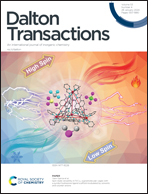2-Methylimidazole-modulated 2D Cu metal–organic framework for 5-hydroxymethylfurfural hydrodeoxygenation†
Abstract
Preparation of the high value-added chemical 2,5-dimethylfuran (2,5-DMF) from the biomass-derived platform molecule 5-hydroxymethylfurfural (HMF) is of great significance in the preparation of biofuels. Here, a bottom-up strategy was used to prepare a metal–organic framework (MOF) material with a two-dimensional nanosheet morphology, named CPM, in which an additive 2-methylimidazole was introduced into the hydrothermal process of Cu2+ ions and terephthalic acid. Subsequently, CPM-700 prepared by heat treatment under an inert atmosphere showed excellent catalytic performance in the reaction of HMF hydrodeoxygenation to 2,5-DMF. The materials before and after pyrogenation were characterized by PXRD, XPS, TEM, N2 adsorption and desorption and so on. It was confirmed that compared with the catalyst derived from the cubic MOF material self-assembled by Cu2+ and terephthalic acid, the morphology of 2D nanosheets was beneficial for the reaction of HMF to 2,5-DMF. Combined with the experimental data, the possible reaction path of 2,5-DMF preparation from HMF is that 2,5-dihydroxymethylfuran was formed by hydrogenation of the aldehyde group on the furan ring, and then 2,5-DMF was obtained by hydrogenolysis. This paper provides an effective route for 2D MOF-derived catalytic materials in the selective hydrogenation of HMF.



 Please wait while we load your content...
Please wait while we load your content...